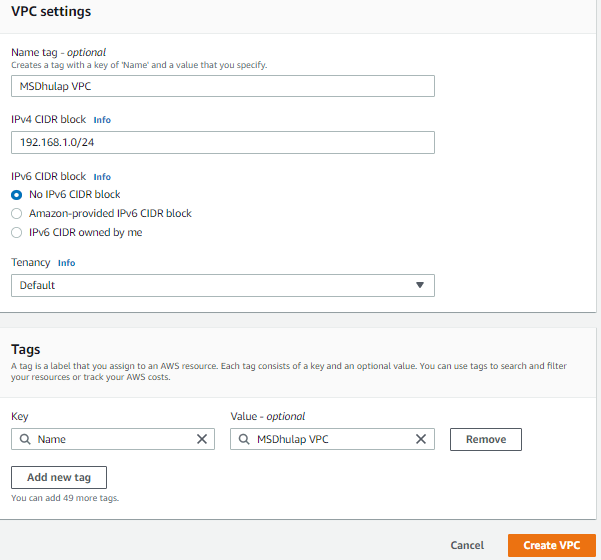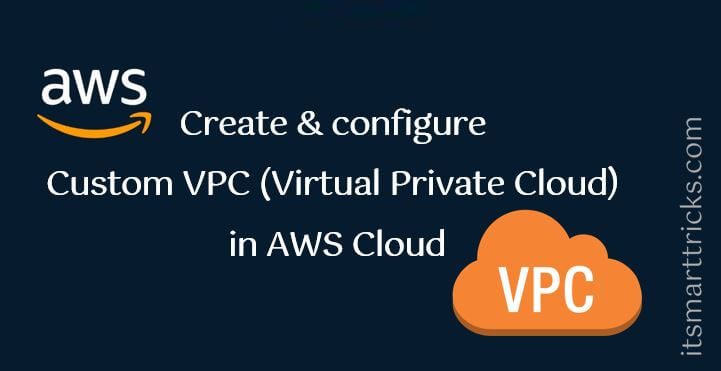In this article, we are going to learn How to Create and configure Custom VPC (Virtual Private Cloud) in AWS Cloud. Amazon Virtual Private Cloud (Amazon VPC) enables you to launch AWS resources into a virtual network that you’ve defined. This virtual network closely resembles a traditional network that you’d operate in your own data center, with the benefits of using the scalable infrastructure of AWS.

VPC – (Virtual Private Cloud):
- Its secure and Logically isolated from other VPCs on AWS.
- VPC cannot span across region .i.e VPC is region specific
- VPC is a virtual infrastructure or a data center.
- AWS Client has full control over resources & Servers hosted inside that VPC.
- Its similar to having your Own Data Center Inside AWS.
- One VPC can have multiple AZ (Min 2 or more).
- Subnet cannot extend beyond AZ.
- Multiple IP subnets inside each AZ.
Types of VPC:
1. Default VPC
- When AWS account is created, its by default created in all AWS region.
- It has default CIDR, Security Groups, N-ACL & Route tables.
- Default Subnets ih each AZ.
- Internet Gateway is also by default.
2. Custom VPC
- This VPC is created by account owner.
- At the time of Creation decide CIDR.
- It also has default Security Groups, N-ACL & Route tables.
- No default Subnet in each AZ.
- Does not have Internet gateway, attach one if you require
CIDR and IP Address range:
- Once the VPC is created you cannot change its CIDR block range(Create New VPC).
- Size of CIDR block Min/28 or Max /16.
- Different CIDR’s in VPC cannot overlap.
- Expand your VPC by adding new CIDR IP address ranges (Secondary- u can delete).
VPC Components:
1. Implied Router
- No request has to be made, automatic facility.
- Implied router automatically does communication between subnets and outside internet world.
2. Route Tables
- These are tables that have entries which says what is the destination and target for that packet.
3. Internet gateways
- VPC without Internet gateway cpmmunicate with the internet – NO.
- Horizontally Scaled, Redundant, Highly available VPC component.
- Only ONE Internet Gateway per VPC.
- It support both IPV4 & IPV6.
4. Security Groups
- Security groups are basically virtual firewalls that protect your Virtual Servers or EC2 Intances.
5. Network Access Control List (N. ACL’s)
- First Line of defense.
- Security group functions at Virtual Nic level where as the Network ACL they work at the subnet level.
6. Virtual private Gateway
- The virtual private gateway will take you to your own premises or headquarters or branches through VPN or Direct Connect.
7. Direct Connect
- AWS Direct Connect is a cloud service solution that makes it easy to establish a dedicated network connection from your premises to AWS.
- In many cases can reduce your network costs, increase bandwidth throughput, and provide a more consistent network experience than Internet- based connections (VPN).
- AWS Direct Connect provides 1 Gbps and 10 Gbps connections, you can easily provision multiple connections if you need more capacity.
- AWS Direct Connect is a cloud service solution that makes it easy to establish a dedicated network connection from your premises to AWS.
Follow the below steps to Create and configure Custom VPC (Virtual Private Cloud) in AWS Cloud :
Log into your AWS console, select the region in which you would like to create a Custom VPC. if you dont want default VPC please delete and create a Custom VPC.
Now, click on Your VPCs in the left sidebar and then click on Create VPC.
VPC settings:
A VPC is an isolated portion of the AWS cloud populated by AWS objects, such as Amazon EC2 instances. You must specify an IPv4 address range when you create a VPC. Specify the IPv4 address range as a Classless Inter-Domain Routing (CIDR) block.
Name tag – optional:
Creates a tag with a key of ‘Name‘ and a value that you specify.
IPv4 CIDR block : You must specify an IPv4 address range for your VPC. Specify the IPv4 address range as a Classless Inter-Domain Routing (CIDR) block; for example, 192.168.1.0/24. A CIDR block size must be between a /16 netmask and /28 netmask.
IPv6 CIDR block : You can associate an Amazon-provided IPv6 CIDR block with the VPC. Amazon provides a fixed size (/56) IPv6 CIDR block, and you cannot choose the range of IPv6 addresses yourself. Alternatively, if you have imported your own IPv6 CIDRs into AWS, you can specify an IPv6 CIDR block from your address pool.
Tenancy : You can run instances in your VPC on single-tenant, dedicated hardware. Select Dedicated to ensure that instances launched in this VPC are dedicated tenancy instances, regardless of the tenancy attribute specified at launch. Select Default to ensure that instances launched in this VPC use the tenancy attribute specified at launch.
Tags :
A tag is a label that you assign to an AWS resource. Each tag consists of a key and an optional value. You can use tags to search and filter your resources or track your AWS costs.
Click on the Create button to create your custom VPC.

After clicking on the Create button, you will now see a message > “You successfully created vpc-03a67ae1b92eae5ea / MSDhulap VPC”.

Now in “Your VPCs” you will see the vpc you created.

Also Read – How to create AWS IAM User? AWS Identity and Access Management (IAM)
That’s all, In this article, we have explained How to Create and configure Custom VPC (Virtual Private Cloud) in AWS Cloud. If you like this article, then just share it and then do subscribe to email alerts for Linux, Windows, macOS, Android, Internet, Firewall and Security, CCTV tutorials. If you have any questions or doubts about this article, please comment.
